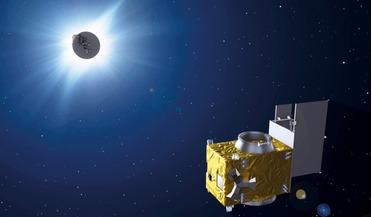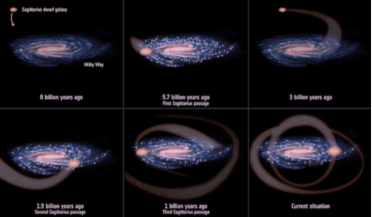 January 2019
Engineering six-hour solar eclipses with formation flying
January 2019
Engineering six-hour solar eclipses with formation flying
... (but along a relative inherently safe orbit), pointing to the Sun, and acquiring again the formation before the next apogee phase (event 3). The breaking and acquisition of the formation is achieved by performing a set of impulsive manoeuvres called...
 25 January 2016
Permanent N2 icecap at Pluto’s north pole may be responsible for an expanding atmosphere
25 January 2016
Permanent N2 icecap at Pluto’s north pole may be responsible for an expanding atmosphere
... of 5 (± 2) % between 2013 and 2015. This trend rules out an ongoing atmospheric collapse as Pluto heads away from the Sun and is most likely due to a permanent N2 ice cap at Pluto’s north rotational pole - a result that is seen in models...
 25 May 2020
Clashing galaxies may have triggered Solar System formation says new study
25 May 2020
Clashing galaxies may have triggered Solar System formation says new study
...as one encounter is suggested to be roughly coincident with the time of the formation of the Sun some 4.7 billion years ago. “The Sun formed at the time when stars were forming in the Milky Way because of the first passage of Sagittarius,” says Carme...
 June 2017
Bepi-Colombo will unveil Mercury’s secrets
June 2017
Bepi-Colombo will unveil Mercury’s secrets
... Propulsion Laboratory (JPL), had noticed that the period of the spacecraft’s orbit around the Sun, after it flew past Mercury, would be almost exactly twice the period of the planet itself, so the spacecraft and the planet would meet again and, with...
 May 2018
PLATO the habitable zone explorer
May 2018
PLATO the habitable zone explorer
... possible from space. Kepler stared for four years at the same patch of sky, while K2, an ingenious extension of the Kepler mission using the radiation pressure from the Sun to stabilise the satellite, is only able to carry out short-duration stares...
 January 2019
Visiting an asteroid to find out how life began
January 2019
Visiting an asteroid to find out how life began
... first, operations will pause as the Sun will get in the way. Solar conjunction occurs when the Sun moves between Ryugu and the Earth, interfering with communication with the spacecraft. From the end of November to the end of December, communication...